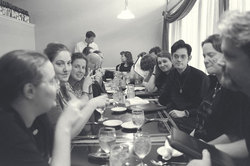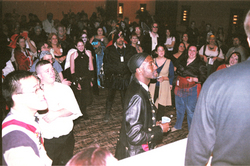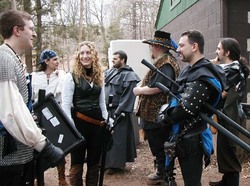Live Action Role Playing (LARP)
Stepping Into The Character...For A Few Hours
Live Action Role Play, commonly called LARP, often comes from tabletop game world settings. Instead of players sitting around a table describing their characters' actions, they are actually "being" their characters, walking around the game-site interacting and role playing with other player-characters. Often, LARP rules see dice replaced with easier-to-carry things, such as ten playing cards numbered Ace-through-Ten, or they use "Rock-Paper-Scissors" to resolve things that would otherwise call for dice. LARP character sheets are rarely over one page long, and are designed to be folded into a pocket and only brought out on occassion. The focus of LARP is the role playing experience, and the costuming.
Benefits of LARP
LARPs are generally aimed and marketed more towards adults, and many of the groups in the United States have a strict policy of only admitting members who are 18 years old or over, some of the most popular ones have whole families take part in activities.
Participating in a LARP is almost like being part of an improvisational theatre performance, where your fellow actors are also the audience, the Game Master - often called a StoryTeller (ST) in LARP - as the Director, and the hosts and organizers as the producers. Social skills can be learned, and LARP gives participants the chance to "be someone else" for the duration of the expereince.
LARP is also a very mainstream activity, though many people don't realize it. Any "reinactment" group is, essentially, participating in a LARP, the only difference being that their activities are scripted, not improvised.
Dangers of LARP
While LARP doesn't carry the same kind of stigmas as Tabletop games, there are always some who look down on people who play role playing games at all. Trying to walk from a parking lot to a game site in an archaic costume might also cause anxiety.
The biggest danger of LARP comes from the interactions with others. In a Tabletop game, only so many players can be supported by a single Game Master, and as such those games tend to be small groups of friends. LARPs can have as many as one thousand people all playing at the same time in the same game site (large games take over whole hotels or campsites). Like with any large social gathering, there are risks of meeting people who might take unwanted interest (especially for female players, especially those who prefer provocative costuming).
Another risk is that some players might have a hard time distinguishing between someone's in-character actions and demeanor versus their real personality. A very mean character portrayed by an exceptionally skilled player might get the reputation of being a mean person, even if they're not.
Above: A player-character (Chris Williams) is honored in the midst of a LARP with over 300 players present
One of the strengths of many LARP groups is the sense of community that they foster. People from all different walks of life might be playing in the same game at the same time, and their mutual interest in LARP brings them together and can be the basis for long-lasting friendships.
Above: LARPing over a nice meal in an Italian resteraunt
"Live Action Role-Playing takes things another step, in that you actually portray the character in question, physically moving from location to location and behaving as your character would. It’s a lot more like free-form acting. You have to know your character’s concept and then teach yourself to react to the actions of others as your character would react. As a person gets more experienced, they can take on roles that are beyond what they, personally, might do in a given situation. This can teach them perspective – looking at things from another point of view."[1]
Unique Skills
LARPs, especially ones with a more historical or medieval focus, boast members who are practised in a broad range of unique or archaic skills. Some members of the SCA (Society for Creative Anachronism) can forge and create their own armor, others can reproduce authentic medieval costume and garb. Members of the SCA and the group NERO (pictured below) can also engage in "fighter's practice", learning swordplay alongside lessons in history.


